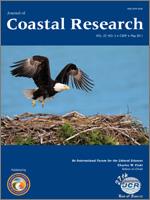Sandy coastal sediments in similar wave-exposure conditions in southeastern New Zealand supported different macrofaunal communities in an area with steeply sloped bathymetry compared with an adjacent area with a shallower slope and, therefore, a more wave-dissipating profile. Assemblages were sampled in autumn and spring along three shore-normal transects (6–30 m water depths) in two areas separated by a small headland. There was no sediment texture stratification in surficial sediments and no seasonal variability in sediment texture. Macrofaunal abundance and taxon richness were higher in both areas in spring. Taxon richness generally increased with depth in both communities. Abundance increased with depth at the more reflective site but decreased with depth at the more dissipative site until a possible autecological point was reached, whereafter both abundance and richness continued to increase with depth and community composition merged into a typical shelf community. This merge point supports the notion of a Wave Exclusion Hypothesis (WEH), a shallow subtidal analogue to the Swash Exclusion Hypothesis (SEH) developed for sandy beach processes, where turbulence and sediment instability selectively exclude macroinvertebrates. Macrofaunal communities in the more reflective area were probably constrained by abiotic factors as suggested by morphological traits of dominant taxa. Communities have largely persisted since the 1960s and 1980s. Variability within such a small spatial scale suggests that coastal management decisions should consider the special nature of nearshore environments as a distinct marine habitat where sediment instability may shape communities through different processes than those present in sheltered inlets or deeper shelf environments.
How to translate text using browser tools
1 May 2011
Macrofaunal Community Patterns of Adjacent Coastal Sediments with Wave-Reflecting or Wave-Dissipating Characteristics
Brian Paavo,
Remco Jonker,
Simon Thrush,
P. Keith Probert
ACCESS THE FULL ARTICLE

Journal of Coastal Research
Vol. 27 • No. 3
May 2011
Vol. 27 • No. 3
May 2011
benthic
epifauna
infauna
Polychaeta
surf
wave exposure




